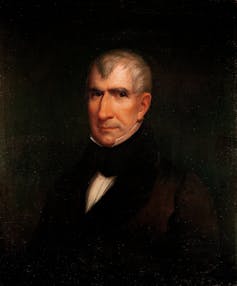Almost all the content and advertising on the internet is customized to each viewer. The impact of this kind of content distribution on the 2016 election is still being explored. But, we can certainly say that the campaigns used this to say different things to different people without having to worry about accuracy.
Addressing this problem by having people screen ads is impractical and legally questionable. A more straightforward solution based on current disclosure laws is being discussed in Congress: Increase transparency by having digital media platforms post all ads on a web page that everyone can view.
Before the web, big data and machine learning, political groups and campaigns reached their target audiences through mass media – newspapers, radio and television. Most everyone saw the same news reports and advertisements at the same times. As a result, the public shared a common base of knowledge about what political candidates were saying. No longer.
Today, digital media platforms track what users look at, search for, post, like and share to micro-target their users with ads they are likely to want to see. Compared to the scattershot approach taken on TV and other mass media, micro-targeted ads are amazingly effective. This is great for the media platforms, who get to make money from advertisers. It is great for consumers, who can trade their time viewing ads they are likely to want to see in exchange for “free” use of the internet. And, it is great for businesses that get to reach their target audiences for less money.
Recent news makes it clear, however, that micro-targeting is not so great for democracy. Micro-targeted advertisements, which are at the heart of the most successful internet business model, allow political groups and others – including foreign countries – to tell Americans tens of thousands of different stories. Each of these messages is customized for people who are predisposed to agree with it, and unavailable for anyone else to check or verify. The net result is to increase divisiveness and disputes about “fake news” as the public’s common set of knowledge is divided into increasingly smaller pieces.
A look to the 19th century
The official portrait of President William Henry Harrison. James Reid Lambdin/White House
The problem of politicians telling different stories to different people is not new. In 1840, William Henry Harrison’s presidential candidacy essentially invented the modern campaign. He was the first to hold mass rallies, make personal appearances and introduce catchy slogans. He realized that he could tailor his messages to different audiences, and even provide different segments of the population with different sets of facts. The people on the receiving end of his speeches would never know their counterparts in a different region were being told something different.
The solution: The traveling press corps made sure that everyone had access to all of a candidate’s speeches. Harrison and other candidates could, of course, still say whatever they want to any audience, but the press coverage made self-contradiction a political liability. Today’s solution is the same: Increase transparency. In the age of micro-targeted internet ads we need to make all ads available to all the people.
An example of ‘fake news’ in the 2004 U.S. presidential campaign.
During the 2004 presidential election, transparency was essential to eliminating fake news. An ad campaign by a group called “Swift Boat Veterans for Truth” was created to discredit Democratic candidate John Kerry. In part because the public at large saw the ads, the effort was unmasked as inaccurate propaganda about Kerry’s service in the Vietnam War. By increasing the transparency around online ads, we the people can hold all politicians, parties and interest groups accountable, and return to reasonable debates based on a common set of facts.
Current solutions aren’t enough
The recent news that Russia tried to manipulate the election with micro-targeted ads on Facebook, Google and Twitter, and that advertisers can micro-target ads based on racist keywords, has led to calls for online media platforms to be more socially responsible and accountable.
The tech companies’ planned response involves hiring more people to review ads and keywords – a form of censorship. Even if each ad and its related targeting keywords could be vetted by the media companies, there are free speech issues involved in rejecting ads. Furthermore, motivated and clever advertisers are likely to find ways to reach their intended demographics.
Taking the lesson from history
As in 1840, Americans need help restoring the transparency that has been lost with changes in how campaigns reach the electorate. If media platforms were required to post all advertisements in an online archive on their websites for at least one year, then consumer groups, political watchdogs, the press and in fact any citizen would be able to monitor the ads being run.
In addition, at least for political ads, the keywords used to target the audience and the group paying for it could be included along with the ad itself. Keeping all ads on a known and publicly available page would make the ads available for all to see for a reasonable amount of time. Advertisers would be held accountable because everyone would be able to see the ad and it would not go away quickly. If we, as citizens, don’t take it upon ourselves to check the archive page, then shame on us.
It won’t solve all of the problems of micro-targeting. Advertisers and campaigns will doubtless try to circumvent whatever rules are in place. The goal is not perfect accountability, but a step toward it. Just as campaign laws require paid political ads on mass media to identify their funding sources, there should be a trail of accountability for advertisements on digital media platforms. This system is technically feasible and could be set up immediately. It is likely to reduce misinformation and curtail foreign manipulation at the same time, and could help the internet live up to its hope of improving – not hindering – democracy.
 Seth Goldstein has received support from NSF, Darpa, ONR, Altera, Xilinx, Intel and Microsoft. He is a member of the ACM and IEEE and a past member of ISAT.
Seth Goldstein has received support from NSF, Darpa, ONR, Altera, Xilinx, Intel and Microsoft. He is a member of the ACM and IEEE and a past member of ISAT.



 Hong Kong Faces Low Turnout in “Patriots-Only” Election Amid Public Grief After Deadly Fire
Hong Kong Faces Low Turnout in “Patriots-Only” Election Amid Public Grief After Deadly Fire  Morgan Stanley Boosts Nvidia and Broadcom Targets as AI Demand Surges
Morgan Stanley Boosts Nvidia and Broadcom Targets as AI Demand Surges  Australia Imposes Sanctions on Taliban Officials Over Human Rights Abuses
Australia Imposes Sanctions on Taliban Officials Over Human Rights Abuses  Bitcoin Reserves Hit 5-Year Low as $2.15B Exits Exchanges – Bulls Quietly Loading the Spring Below $100K
Bitcoin Reserves Hit 5-Year Low as $2.15B Exits Exchanges – Bulls Quietly Loading the Spring Below $100K  Trump’s Name Appears on U.S. Institute of Peace Ahead of Rwanda–Congo Deal Signing
Trump’s Name Appears on U.S. Institute of Peace Ahead of Rwanda–Congo Deal Signing  Asia’s IPO Market Set for Strong Growth as China and India Drive Investor Diversification
Asia’s IPO Market Set for Strong Growth as China and India Drive Investor Diversification  Cuba Quietly Signals Openness to Post-Maduro Venezuela as U.S. Pressure Intensifies
Cuba Quietly Signals Openness to Post-Maduro Venezuela as U.S. Pressure Intensifies  CFPB to Review Anti-Discrimination Policies and Fair Lending Rules Amid Policy Shift
CFPB to Review Anti-Discrimination Policies and Fair Lending Rules Amid Policy Shift  Pentagon Probe Finds Hegseth’s Use of Signal Risked Exposing Sensitive Yemen Strike Details
Pentagon Probe Finds Hegseth’s Use of Signal Risked Exposing Sensitive Yemen Strike Details  Trump Meets Mexico and Canada Leaders After 2026 World Cup Draw Amid USMCA Tensions
Trump Meets Mexico and Canada Leaders After 2026 World Cup Draw Amid USMCA Tensions  Australia and Japan Strengthen Defence Cooperation Amid Rising Regional Tensions
Australia and Japan Strengthen Defence Cooperation Amid Rising Regional Tensions  Airline Loyalty Programs Face New Uncertainty as Visa–Mastercard Fee Settlement Evolves
Airline Loyalty Programs Face New Uncertainty as Visa–Mastercard Fee Settlement Evolves  Bitcoin Defies Gravity Above $93K Despite Missing Retail FOMO – ETF Inflows Return & Whales Accumulate: Buy the Dip to $100K
Bitcoin Defies Gravity Above $93K Despite Missing Retail FOMO – ETF Inflows Return & Whales Accumulate: Buy the Dip to $100K 
































